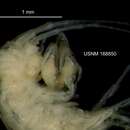Comprehensive Description
provided by Smithsonian Contributions to Zoology
Stygobromus pseudospinosus
Stygobromus spinosus (Hubricht and Mackin).—Hubricht, 1943:697 [in part].—Barnard, 1958:74 [in part].—Hubricht, 1959:878 [in part].—Nicholas, 1960:129 [in part].—Holsinger, 1963:29 [in part]; 1964:62 [in part].—Karaman, 1974:119 [in part].
Stygobromus species C.—Holsinger, 1969a:29–30.
MATERIAL EXAMINED.—VIRGINIA. Page Co.: Luray Caverns, holotype (USNM 168845), 94 paratypes (USNM), L. Hubricht, 14 Aug 1939; additional paratypes as follows: 2 (USNM), J. M. Valentine, 6 Aug 1930; 10 (USNM), J. P. E. Morrison, 2 Mar 1941; 3 (USNM), J. P. E. Morrison, 15 Feb 1942; 2 , 1 (JRH), J. R. Holsinger, 15 May 1964.
DIAGNOSIS.—A moderately small cavernicolous species, distinguished from S. spinosus, to which it is apparently closely related, by more spine teeth on palms of gnathopods, narrower bases of pereopods 6 and 7, shorter and fewer spines on uropod 3 and telson, proportionately longer telson, and less spinose uropods 1 and 2 (especially in male). Largest male, 4.0 mm; largest females, 7.0 mm.
FEMALE.—Antenna 1, 50–60 percent length of body, 50–60 percent longer than antenna 2; primary flagellum with 13–17 segments. Antenna 2, flagellum with 3 segments. Mouthparts generally similar to those of S. spinosus except as noted: Maxilla 1, palp with 7 or 8 setae on apex. Maxilla 2, inner plate with oblique row of 8 or 9 plumose setae on inner margin. Inner plate of maxilliped with 3 bladelike spines, 1 plumose spine and 2 naked setae apically; 2 plumose spines (or setae) subapically on inner margin.
Propod of gnathopod 1 a little larger than 2nd propod; palmar margin slightly concave, armed with double row of 6 spine teeth; defining angle with 3 long spine teeth on outside, 2 shorter ones on inside; medial setae singly inserted. Dactyl nail of gnathopod 1 long. Coxal plate of gnathopod 1 longer than broad, margin with 2 setae. Propod of gnathopod 2: palm with double row of 6 spine teeth; defining angle with 2 long spine teeth on outside, 4 very small ones on inside; medial setae singly inserted; posterior margin with 2 or 3 sets setae. Dactyl nail of gnathopod 2 long. Coxal plates of gnathopod 2 and pereopod 3 slightly longer than broad, margins with 3 setae each. Coxal plate of pereopod 4 about as broad as long, reaching about 1/3 length of basis, margin with 4 setae. Pereopod 7 a little longer than pereopod 6, 40–50 percent length of body, about 30 percent longer than pereopod 5. Bases of pereopods 6 and 7 rather narrow, about as broad proximally as distally; posterior margins slightly convex; distoposterior lobes poorly developed, broadly rounded. Dactyls of pereopods 5–7 about 33 percent length of corresponding propods. Gills and brood plates like those of S. spinosus.
Pleonal plates: posterior margins sinuate distally, those of plates 1 and 3 with 4 setae each, that of plate 2 with 6 setae; posterior corners about like those of S. spinosus; ventral margin of plate 2 with 1 spine, that of plate 3 with 2 spines. Uronites free. Uropod 1: inner ramus slightly longer than outer ramus, about 75 percent length of peduncle, armed with 8 spines; outer ramus with 10 spines, peduncle with 11 spines. Uropod 2: inner ramus longer than outer ramus, subequal in length to peduncle, armed with 9 spines; outer ramus with 8 spines; peduncle with 7 spines. Uropod 3: ramus about 20 percent length of peduncle, with 2 apical spines. Telson longer than broad, gently tapering distally; apical margin entire, armed with 14 spines.
MALE.—Differing from female as follows: Propod of gnathopod 1 with 3 or 4 fewer spine teeth, palm straight. Propod of gnathopod 2 with 10 or 11 spine teeth and fewer setae. Uropod 1: inner ramus subequal in length to outer ramus, about 85 percent length of peduncle, armed with 8 spines; outer ramus with 11 spines; peduncle with 5 spines; peduncular process about like that of S. spinosus. Uropod 2: inner ramus subequal in length to outer ramus, a little longer than peduncle, armed with 7 spines; outer ramus with 7 spines; peduncle with 4 spines. Telson with 10 or 11 apical spines.
TYPE-LOCALITY.—Luray Caverns, located just west of Luray in Page Co., Virginia, is a well known commercial cave developed in limestone of the Beek-mantown Formation (Lower Ordovician age). The cave contains a number of drip pools but does not have a flowing stream.
DISTRIBUTION AND ECOLOGY.—This species is known only from its type-locality, where it was collected from a series of drip pools on five different occasions between 1930 and 1964. Of the 113 specimens collected, 112 have been females, indicating, as pointed out by Hubricht (1943:697) and Culver and Holsinger (1969), a trend toward parthenogenesis in certain cave species of this genus. Collections are available from winter, spring, and summer, and ovigerous females or females with setose brood plates have been found during all three seasons. Collections made on 14 August 1939 and 2 March 1941 contained seven ovigerous females ranging in size from 4.4 to 6.0 mm (X = 5.19). The mean number of eggs per female was 5. One female from the August collection had a newly hatched young (1.4 mm in length) in the brood pouch.
- bibliographic citation
- Holsinger, John R. 1978. "Systematics of the subterranean amphipod genus Stygobromus (Crangonyctidae) : Part II. Species of the eastern United States." Smithsonian Contributions to Zoology. 1-144. https://doi.org/10.5479/si.00810282.266

